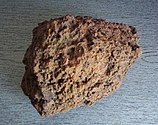Portal:Wetlands/Selected article/40
Bog iron is a form of impure iron deposit that develops in bogs or swamps by the chemical or biochemical oxidation of iron carried in solution. In general, bog ores consist primarily of iron oxyhydroxides, commonly goethite (FeO(OH)).
Iron-bearing groundwater typically emerges as a spring. The iron is oxidized to ferric hydroxide upon encountering the oxidizing environment of the surface. Bog ore often combines goethite, magnetite and vugs or stained quartz. Oxidation may occur through enzyme catalysis by iron bacteria. It is not clear whether the magnetite precipitates upon first contact with oxygen, then oxidizes to ferric compounds, or whether the ferric compounds are reduced when exposed to anoxic conditions upon burial beneath the sediment surface and reoxidized upon exhumation at the surface.
Iron made from bog ore will often contain residual silicates, which can form a glassy coating that grants some resistance to rusting.
Iron smelting from bog iron was invented during the Pre-Roman Iron Age, and most Viking Age iron was smelted from bog iron. The bog iron deposits of Northern and Northeastern Europe were created after the Ice Age ended, on postglacial plains. In Russia, bog ore was the principal source of iron until the 16th century, when the superior ores of Ural Mountains became available. (Full article...)

